Are you ready to brighten up your meals with the vibrant zing of lemon? From quick weeknight dinners to refreshing seasonal favorites, these 24 recipes showcase how this citrus superstar can transform ordinary dishes into extraordinary culinary experiences. Let’s explore these zesty creations that will add sunshine to your kitchen and keep your taste buds dancing!
Lemon Herb Grilled Chicken
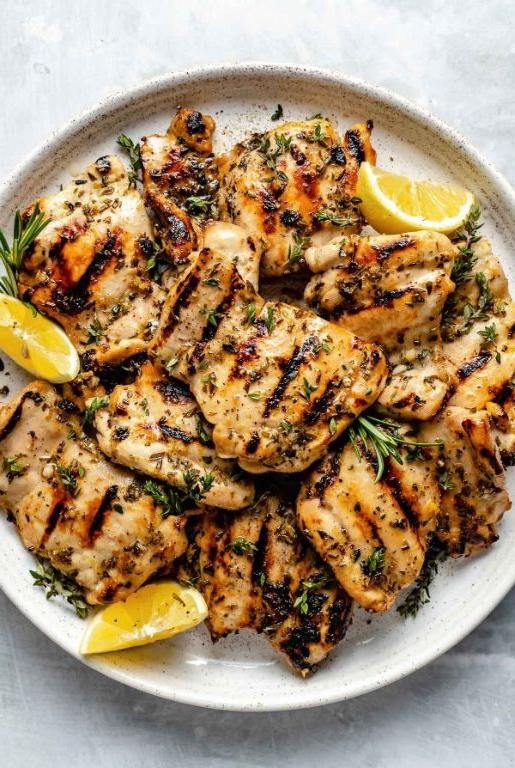
Savor the perfect harmony of bright citrus and aromatic herbs in this sophisticated grilled chicken dish, where tender poultry meets the vibrant essence of summer. Each succulent bite delivers a delicate balance of zesty lemon notes and earthy herbaceous undertones, creating an elegant centerpiece for any alfresco dining occasion. This recipe transforms simple ingredients into a culinary masterpiece through precise technique and thoughtful flavor layering.
5
portions15
minutes35
minutesIngredients
- 4 bone-in, skin-on chicken thighs (approximately 6 ounces each)
- 3 tablespoons extra-virgin olive oil
- 2 tablespoons freshly squeezed lemon juice
- 1 tablespoon minced fresh rosemary
- 1 tablespoon chopped fresh thyme
- 2 teaspoons finely grated lemon zest
- 3 cloves garlic, minced
- 1 teaspoon kosher salt
- ½ teaspoon freshly cracked black pepper
Instructions
- Pat chicken thighs completely dry with paper towels to ensure proper browning.
- Whisk together extra-virgin olive oil, freshly squeezed lemon juice, minced fresh rosemary, chopped fresh thyme, finely grated lemon zest, minced garlic, kosher salt, and freshly cracked black pepper in a medium bowl.
- Coat chicken thighs thoroughly with the marinade, making sure to lift the skin and rub some marinade directly onto the meat.
- Cover the bowl with plastic wrap and refrigerate for at least 4 hours or overnight for optimal flavor penetration.
- Preheat a gas or charcoal grill to medium-high heat, approximately 400°F, creating both direct and indirect heat zones.
- Place chicken thighs skin-side down on the direct heat zone and grill for 6-8 minutes until the skin develops deep golden-brown grill marks and releases easily from the grates.
- Flip the chicken and grill for another 4 minutes on the second side to develop color.
- Move chicken to the indirect heat zone, cover the grill, and continue cooking for 15-20 minutes until the internal temperature reaches 165°F when measured with an instant-read thermometer inserted into the thickest part of the thigh without touching bone.
- Transfer the grilled chicken to a clean cutting board and let it rest for 5 minutes to allow juices to redistribute evenly throughout the meat.
Ultimately, this lemon herb grilled chicken achieves a sublime textural contrast between the crackling, herb-infused skin and the exceptionally moist, tender meat beneath. The bright citrus notes dance elegantly with the earthy herbal undertones, creating a sophisticated flavor profile that pairs beautifully with roasted summer vegetables or a crisp arugula salad. Consider serving it alongside grilled lemon halves for an extra burst of fresh acidity that elevates the entire dining experience.
Zesty Lemon Pasta Primavera

Glistening with the vibrant essence of spring, this Zesty Lemon Pasta Primavera transforms humble ingredients into an elegant symphony of flavors, where each element contributes to a harmonious and sophisticated dish. Perfectly al dente pasta provides the foundation for a medley of seasonal vegetables, all brought together by a bright, citrus-kissed sauce that awakens the palate. This recipe celebrates the freshness of the season while offering a refined yet approachable centerpiece for any gathering.
3
servings15
minutes25
minutesIngredients
- 12 ounces dried linguine pasta
- 3 tablespoons extra-virgin olive oil, divided
- 2 medium shallots, finely minced
- 3 cloves garlic, thinly sliced
- 1 cup fresh asparagus, trimmed and cut into 1-inch pieces on the bias
- 1 cup fresh sugar snap peas, strings removed
- 1 medium yellow squash, cut into ¼-inch half-moons
- ½ cup dry white wine
- Zest and juice of 2 large lemons
- ½ cup heavy cream
- ¼ cup freshly grated Parmigiano-Reggiano cheese
- 2 tablespoons unsalted butter
- ¼ cup fresh basil leaves, chiffonaded
- Kosher salt and freshly cracked black pepper
Instructions
- Bring a large stockpot of heavily salted water to a rolling boil over high heat.
- Add linguine to the boiling water and cook for 8-10 minutes until al dente, stirring occasionally to prevent sticking.
- While pasta cooks, heat 2 tablespoons olive oil in a large skillet over medium heat until shimmering.
- Sauté minced shallots for 2-3 minutes until translucent and fragrant.
- Add sliced garlic and cook for 30 seconds until aromatic but not browned.
- Increase heat to medium-high and add asparagus, cooking for 2 minutes until bright green and slightly tender.
- Add sugar snap peas and yellow squash, sautéing for 3 minutes until vegetables are crisp-tender.
- Pour in white wine and simmer for 2 minutes until reduced by half, scraping any browned bits from the pan.
- Reduce heat to low and stir in lemon zest, lemon juice, and heavy cream.
- Simmer the sauce gently for 3 minutes until slightly thickened, being careful not to boil.
- Reserve 1 cup of pasta cooking water before draining the linguine.
- Add drained pasta directly to the skillet with the vegetable mixture.
- Toss pasta with the sauce, adding reserved pasta water 2 tablespoons at a time until the sauce coats the noodles beautifully.
- Remove skillet from heat and stir in Parmigiano-Reggiano, butter, and remaining tablespoon of olive oil until emulsified.
- Season generously with kosher salt and freshly cracked black pepper.
- Garnish with chiffonaded basil just before serving.
Present this vibrant creation immediately, allowing the silky sauce to cling to each strand of pasta while the vegetables maintain their delightful crunch. The bright acidity of lemon cuts through the richness of the cream, creating a perfectly balanced dish that feels both luxurious and refreshing. For an elegant presentation, serve in shallow bowls garnished with additional lemon zest and a drizzle of high-quality olive oil.
Lemon Garlic Shrimp Skewers
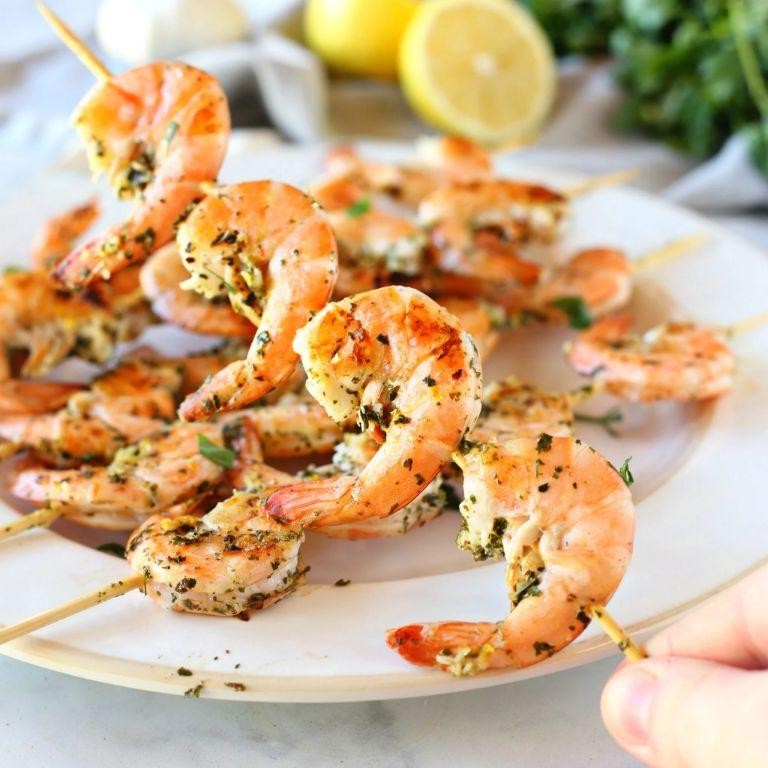
Warm summer evenings call for effortless yet sophisticated dishes that capture the essence of coastal dining. These Lemon Garlic Shrimp Skewers deliver precisely that—a harmonious blend of bright citrus and aromatic garlic that transforms simple seafood into an elegant centerpiece. Perfect for al fresco entertaining or a quick weeknight indulgence, they promise to transport your palate to sun-drenched shores with every succulent bite.
4
portions25
minutes4
minutesIngredients
- 1 pound large wild-caught shrimp, peeled and deveined
- 3 tablespoons extra-virgin olive oil
- 2 tablespoons freshly squeezed lemon juice
- 4 cloves garlic, finely minced
- 1 teaspoon lemon zest, finely grated
- 1/2 teaspoon smoked paprika
- 1/4 teaspoon crushed red pepper flakes
- 1/4 cup fresh parsley, finely chopped
- Bamboo skewers, soaked in water for 30 minutes
Instructions
- In a medium glass bowl, whisk together the extra-virgin olive oil, freshly squeezed lemon juice, finely minced garlic, finely grated lemon zest, smoked paprika, and crushed red pepper flakes until fully emulsified.
- Add the peeled and deveined shrimp to the marinade, tossing gently to coat each piece thoroughly, then refrigerate for exactly 20 minutes to allow flavors to penetrate without overcuring the delicate flesh.
- While shrimp marinates, soak bamboo skewers in cold water for 30 minutes to prevent charring during grilling—a crucial step for maintaining even cooking.
- Thread 4-5 marinated shrimp onto each prepared skewer, piercing through both the head and tail ends to secure them firmly and ensure they lay flat on the grill.
- Preheat a grill or grill pan to medium-high heat (400°F), brushing the grates lightly with oil to create a non-stick surface that imparts clean sear marks.
- Place shrimp skewers on the hot grill and cook for 2 minutes per side, until the flesh turns opaque with firm pink edges and slightly caramelized surfaces.
- Transfer skewers to a platter, immediately sprinkling with finely chopped fresh parsley to wilt gently from residual heat and brighten the dish’s aroma.
You’ll marvel at how the shrimp achieve a perfect balance of tender juiciness and smoky crispness, with the lemon-garlic marinade caramelizing into a glossy, nuanced glaze. For an inspired presentation, serve these skewers atop a bed of saffron-infused couscous or alongside grilled asparagus spears, allowing the vibrant flavors to shine through each complementary bite.
Lemon Drizzle Cake
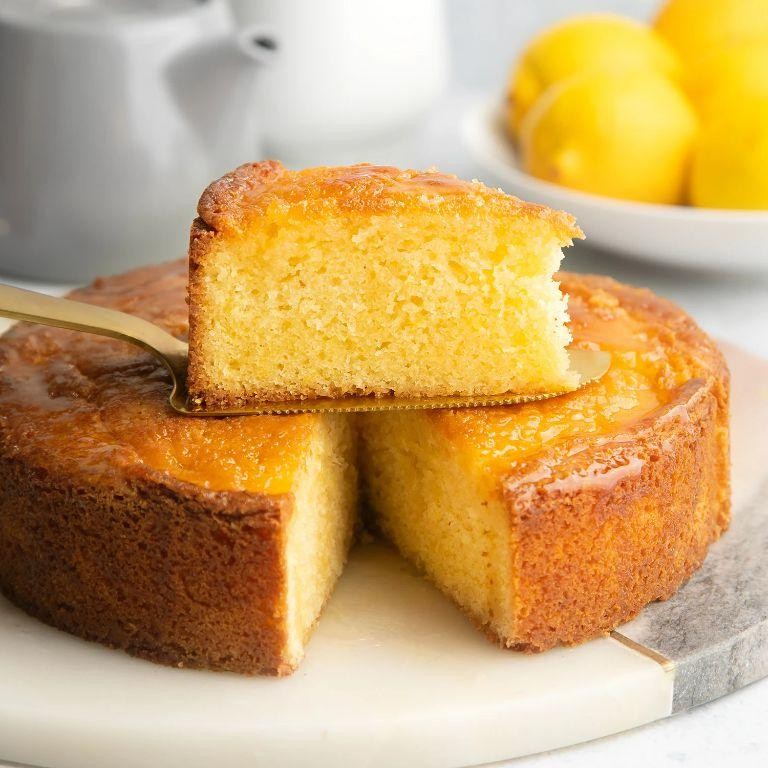
Dazzling in its simplicity yet sophisticated in flavor, the classic Lemon Drizzle Cake embodies the perfect balance of tart citrus and delicate sweetness. This timeless confection features a moist, tender crumb that practically melts on the tongue, while the signature lemon glaze creates a shimmering, crackled finish. Each slice offers a bright burst of sunshine, making it an elegant addition to afternoon tea or a refined dessert for special occasions.
1
loaf20
minutes50
minutesIngredients
– 1¾ cups cake flour, sifted
– 1 cup granulated cane sugar
– ½ cup European-style cultured butter, softened
– 3 pasture-raised eggs, lightly beaten
– ½ cup whole milk Greek yogurt
– 2 tablespoons freshly squeezed lemon juice
– 1 tablespoon finely grated lemon zest
– 1 teaspoon pure vanilla extract
– 2 teaspoons aluminum-free baking powder
– ¼ teaspoon fine sea salt
– For the glaze: ¾ cup confectioners’ sugar and 3 tablespoons freshly squeezed lemon juice
Instructions
1. Preheat your oven to 350°F and prepare a 9-inch loaf pan by brushing it with softened butter and dusting with flour.
2. In a medium bowl, whisk together the sifted cake flour, baking powder, and fine sea salt until thoroughly combined.
3. Using a stand mixer fitted with the paddle attachment, cream the softened European-style butter and granulated cane sugar on medium-high speed for precisely 4 minutes until pale and fluffy.
4. Gradually incorporate the lightly beaten pasture-raised eggs into the butter-sugar mixture, adding them one at a time and mixing for 30 seconds after each addition.
5. Blend in the whole milk Greek yogurt, freshly squeezed lemon juice, finely grated lemon zest, and pure vanilla extract until just incorporated.
6. Gently fold the dry ingredients into the wet mixture using a silicone spatula, taking care not to overmix—stop when the last streaks of flour disappear.
7. Transfer the batter to the prepared loaf pan and smooth the surface with an offset spatula.
8. Bake at 350°F for 45-50 minutes until the cake springs back when lightly pressed and a toothpick inserted into the center emerges clean.
9. Cool the cake in the pan on a wire rack for 15 minutes before carefully turning it out to cool completely.
10. While the cake cools, prepare the glaze by whisking confectioners’ sugar with freshly squeezed lemon juice until it reaches a smooth, pourable consistency.
11. Drizzle the glaze evenly over the completely cooled cake, allowing it to cascade down the sides and form delicate crystalline patterns. The cake’s tender crumb provides the perfect textural contrast to the crisp sugar crust, while the bright lemon flavor cuts through the richness with refreshing clarity. Serve thin slices alongside Earl Grey tea, or elevate it further with a dollop of lemon curd and fresh berries for an elegant dessert presentation.
Lemon and Thyme Roasted Vegetables
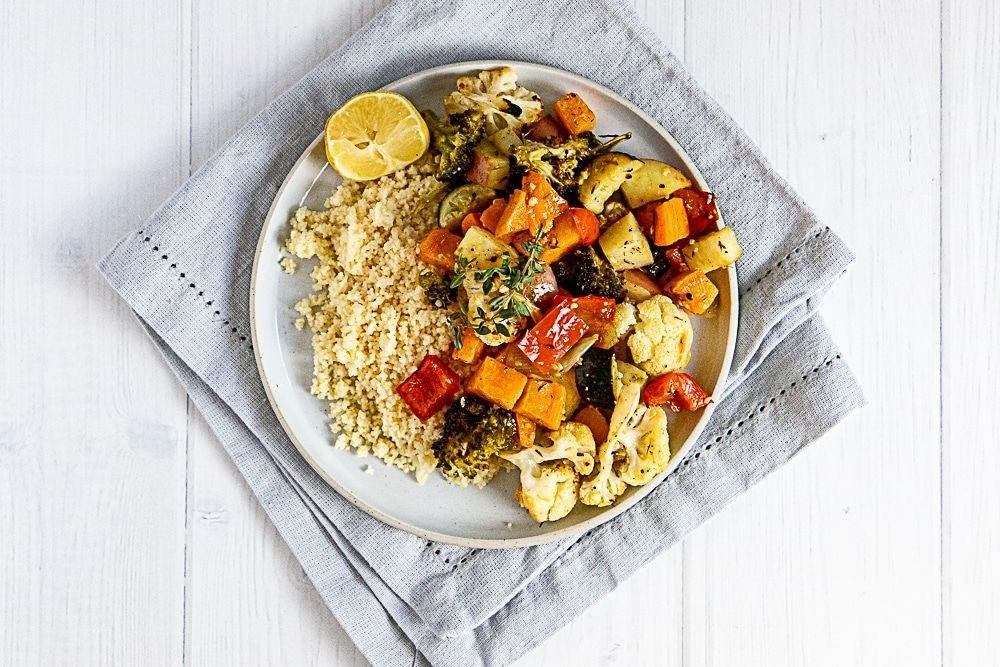
A symphony of seasonal produce awaits transformation in this elegant roasted vegetable medley, where bright citrus notes dance with earthy herbs to create a dish that celebrates simplicity and sophistication. As autumn’s bounty reaches its peak, these carefully selected vegetables emerge from the oven with caramelized edges and tender interiors, offering both visual appeal and complex flavor development. The marriage of fresh lemon and aromatic thyme elevates humble root vegetables to centerpiece status, perfect for intimate dinners or festive gatherings alike.
2
servings15
minutes38
minutesIngredients
- 1 pound rainbow carrots, peeled and cut into 2-inch batons
- 1 pound petite tri-color potatoes, halved
- 2 medium red onions, cut into 1-inch wedges
- 3 tablespoons extra virgin olive oil
- 2 tablespoons freshly squeezed lemon juice
- 1 tablespoon fresh thyme leaves
- 1 teaspoon flaky sea salt
- ½ teaspoon freshly cracked black pepper
- 2 garlic cloves, thinly sliced
- 1 lemon, cut into ¼-inch slices
Instructions
- Preheat your oven to 425°F and position one rack in the upper third of the oven.
- Combine rainbow carrots, petite tri-color potatoes, and red onion wedges in a large mixing bowl.
- Drizzle the vegetables with extra virgin olive oil, using your hands to coat each piece thoroughly.
- Sprinkle the vegetables with flaky sea salt and freshly cracked black pepper, ensuring even distribution.
- Arrange the seasoned vegetables in a single layer on a parchment-lined baking sheet, leaving space between pieces for proper air circulation.
- Roast the vegetables on the upper rack for 20 minutes at 425°F until edges begin to caramelize.
- Remove the baking sheet from the oven and scatter thinly sliced garlic cloves and fresh thyme leaves over the vegetables.
- Arrange the lemon slices throughout the vegetable mixture, tucking them between larger pieces.
- Return the baking sheet to the oven and continue roasting for 15-18 minutes until potatoes are fork-tender and carrots develop deep golden edges.
- Transfer the roasted vegetables to a serving platter and drizzle with freshly squeezed lemon juice.
Lemon and thyme roasted vegetables emerge with a delightful contrast of textures—crisp-tender carrots, creamy potato centers, and caramelized onion edges that melt on the tongue. The bright acidity of lemon cuts through the natural sweetness of the roasted vegetables, while thyme provides an earthy backbone that lingers pleasantly. For an elegant presentation, serve atop a bed of creamy polenta or alongside seared duck breast, allowing the vibrant colors and aromas to shine as the centerpiece of your autumn table.
Lemon Basil Pesto Pasta
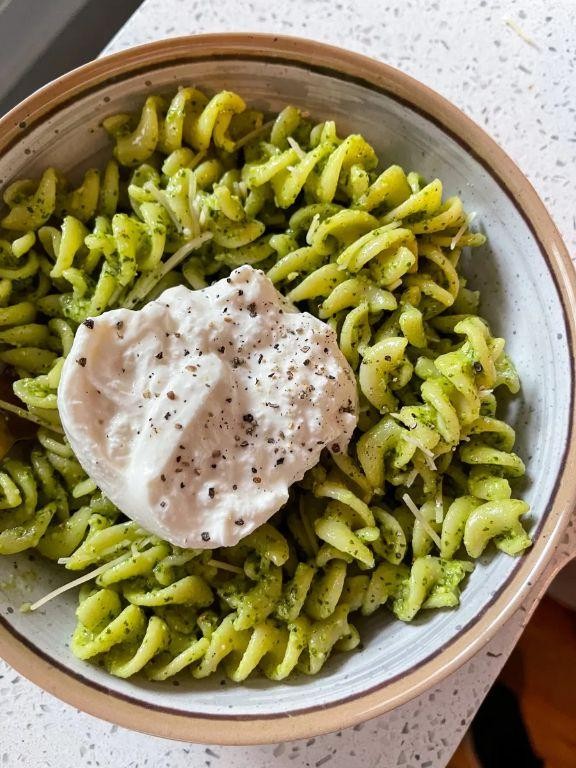
Radiating with vibrant freshness, this lemon basil pesto pasta marries the bright acidity of citrus with the aromatic sweetness of garden-fresh herbs. Each strand of pasta becomes a canvas for this sophisticated sauce, creating a dish that feels both elegantly simple and deeply satisfying. The harmonious balance of flavors transforms ordinary ingredients into an extraordinary culinary experience.
2
servings15
minutes11
minutesIngredients
– 12 ounces dried linguine pasta
– 2 cups fresh basil leaves, packed
– 1/2 cup extra virgin olive oil
– 1/3 cup pine nuts, lightly toasted
– 2 garlic cloves, peeled
– 1/2 cup Parmigiano-Reggiano cheese, freshly grated
– 2 tablespoons fresh lemon juice
– 1 teaspoon lemon zest, finely grated
– 1/2 teaspoon sea salt
– 1/4 teaspoon freshly cracked black pepper
Instructions
1. Bring 4 quarts of heavily salted water to a rolling boil in a large stockpot.
2. Add 12 ounces of dried linguine pasta to the boiling water and cook for 9-11 minutes until al dente, stirring occasionally to prevent sticking.
3. While pasta cooks, combine 2 cups packed fresh basil leaves, 1/3 cup lightly toasted pine nuts, and 2 peeled garlic cloves in a food processor.
4. Pulse the mixture 8-10 times until coarsely chopped, scraping down the sides with a spatula between pulses.
5. With the processor running on low speed, slowly drizzle in 1/2 cup extra virgin olive oil until the mixture forms a coarse paste.
6. Transfer the basil mixture to a medium bowl and stir in 1/2 cup freshly grated Parmigiano-Reggiano cheese, 2 tablespoons fresh lemon juice, and 1 teaspoon finely grated lemon zest.
7. Season the pesto with 1/2 teaspoon sea salt and 1/4 teaspoon freshly cracked black pepper, then whisk vigorously to emulsify.
8. Reserve 1/2 cup of the starchy pasta cooking water before draining the cooked linguine.
9. Return the drained pasta to the warm pot and immediately toss with the prepared pesto sauce.
10. Gradually add the reserved pasta water, 2 tablespoons at a time, while tossing continuously until the sauce lightly coats each strand.
11. Divide the pasta among warmed serving bowls and garnish with additional basil leaves and cheese if desired. Zestful and vibrant, the pasta boasts a creamy emulsion that clings beautifully to each strand while maintaining the basil’s bright green hue. The pine nuts provide subtle crunch against the tender linguine, while the lemon zest adds bursts of citrus essence that cut through the richness. For an elegant presentation, serve alongside grilled shrimp or roasted cherry tomatoes to complement the pesto’s herbal notes.
Lemon Ricotta Pancakes

Perfectly balancing delicate texture with vibrant citrus notes, these lemon ricotta pancakes elevate the classic breakfast staple into an elegant brunch centerpiece. Their cloud-like crumb and subtle tang create a sophisticated foundation for both sweet and savory accompaniments, making them equally suited for leisurely weekend mornings or celebratory gatherings.
12
pancakes15
minutes20
minutesIngredients
- 1 ½ cups all-purpose flour, sifted
- 2 teaspoons baking powder
- ¼ teaspoon fine sea salt
- 3 large pasture-raised eggs, separated and lightly beaten
- 1 cup whole-milk ricotta cheese
- ¾ cup whole milk
- ¼ cup granulated sugar
- 2 tablespoons freshly squeezed lemon juice
- 1 tablespoon lemon zest
- 1 teaspoon pure vanilla extract
- 3 tablespoons clarified butter, for cooking
- Pure maple syrup, for serving
Instructions
- Whisk together sifted flour, baking powder, and fine sea salt in a large mixing bowl until thoroughly combined.
- In a separate bowl, combine egg yolks, ricotta cheese, whole milk, granulated sugar, freshly squeezed lemon juice, lemon zest, and pure vanilla extract, whisking until the mixture achieves a smooth, homogeneous consistency.
- Gently fold the wet ingredients into the dry ingredients using a rubber spatula, taking care not to overmix—the batter should remain slightly lumpy to ensure tender pancakes.
- In a clean, dry bowl, whip the egg whites to stiff peaks using an electric mixer on medium-high speed for approximately 2-3 minutes, until they hold their shape when the beaters are lifted.
- Fold the whipped egg whites into the batter in three additions using a gentle, lifting motion to maintain airiness and create a light texture.
- Heat a non-stick skillet or griddle over medium heat (325°F) and brush with 1 tablespoon of clarified butter.
- Pour ¼ cup portions of batter onto the heated surface, leaving 2 inches between pancakes to allow for even spreading.
- Cook for 2-3 minutes until the edges appear set and bubbles form across the surface, then flip using a thin-edged spatula.
- Continue cooking for an additional 1-2 minutes until the second side develops a golden-brown crust and the centers spring back lightly when pressed.
- Transfer cooked pancakes to a wire rack in a single layer rather than stacking them, which prevents steam from making the bottoms soggy.
- Repeat the cooking process with remaining batter, brushing the skillet with additional clarified butter between batches to ensure proper browning.
Fluffy yet substantial, these pancakes boast a delicate crumb that melts on the tongue while the ricotta provides subtle richness against the bright lemon accent. For an elegant presentation, layer them with lemon curd and fresh berries, or drizzle with lavender-infused honey to complement the citrus notes. The sophisticated balance of flavors makes them equally delightful when served with crème fraîche and smoked salmon for a savory twist.
Spicy Lemon Chicken Piccata
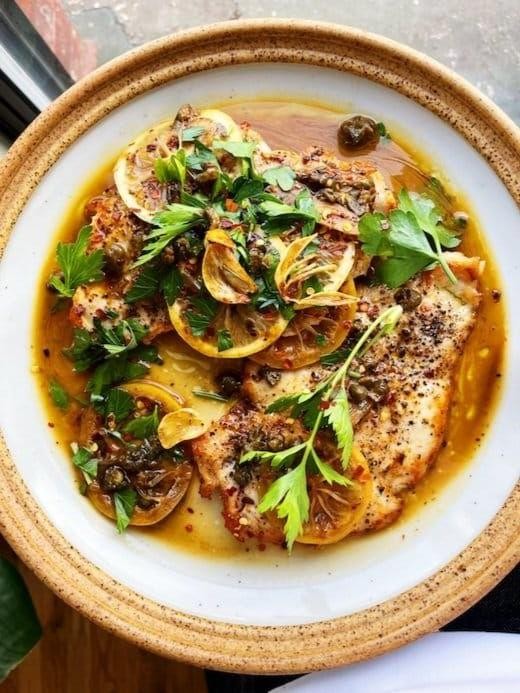
Heirloom culinary traditions find their contemporary expression in this vibrant reinterpretation of chicken piccata, where fiery Calabrian chilies dance with bright Meyer lemon in a sophisticated symphony of flavors. This elevated version transforms the classic Italian-American staple into a dish worthy of any discerning dinner table, balancing heat and acidity with remarkable finesse. The result is a culinary experience that both comforts and excites the palate.
3
servings15
minutes20
minutesIngredients
– 4 boneless, skinless chicken breasts, pounded to ¼-inch thickness
– ½ cup all-purpose flour
– 1 teaspoon kosher salt
– ½ teaspoon freshly cracked black pepper
– 3 tablespoons clarified butter
– 2 tablespoons extra virgin olive oil
– 3 garlic cloves, thinly sliced
– 2 tablespoons Calabrian chili paste
– ½ cup dry white wine, such as Sauvignon Blanc
– 1 cup chicken stock, preferably homemade
– 2 Meyer lemons, one juiced and one thinly sliced
– 2 tablespoons brined capers, drained
– 2 tablespoons unsalted butter, chilled and cubed
– 2 tablespoons fresh Italian parsley, finely chopped
Instructions
1. Place chicken breasts between two sheets of parchment paper and pound uniformly to ¼-inch thickness using a meat mallet.
2. Combine flour, kosher salt, and freshly cracked black pepper in a shallow dish.
3. Dredge each chicken breast thoroughly in the flour mixture, shaking off excess.
4. Heat clarified butter in a large skillet over medium-high heat until it shimmers.
5. Add chicken breasts and cook for 3-4 minutes until golden brown crust forms.
6. Flip chicken and cook additional 3 minutes until internal temperature reaches 165°F.
7. Transfer chicken to a warm plate and tent with foil.
8. Reduce heat to medium and add extra virgin olive oil to the same skillet.
9. Sauté thinly sliced garlic cloves for 30 seconds until fragrant but not browned.
10. Stir in Calabrian chili paste and cook for 1 minute to bloom the flavors.
11. Deglaze the pan with dry white wine, scraping up all browned bits with a wooden spoon.
12. Simmer until wine reduces by half, approximately 2 minutes.
13. Pour in chicken stock and bring to a gentle boil.
14. Add Meyer lemon juice and thin lemon slices, simmering for 3 minutes.
15. Stir in drained capers and cook for 1 minute to warm through.
16. Remove skillet from heat and whisk in chilled butter cubes until emulsified.
17. Return chicken to the skillet, spooning sauce over each breast.
18. Garnish with finely chopped Italian parsley just before serving.
Remarkably tender chicken cutlets provide the perfect canvas for this bold sauce, where the lingering heat of Calabrian chilies gradually unfolds against the bright acidity of Meyer lemon. The capers contribute briny pops that cut through the richness, creating a beautifully balanced dish that feels simultaneously rustic and refined. Serve this elegant preparation over saffron-infused risotto or alongside roasted fingerling potatoes to soak up every last drop of the vibrant sauce.
Grilled Lemon Pepper Salmon
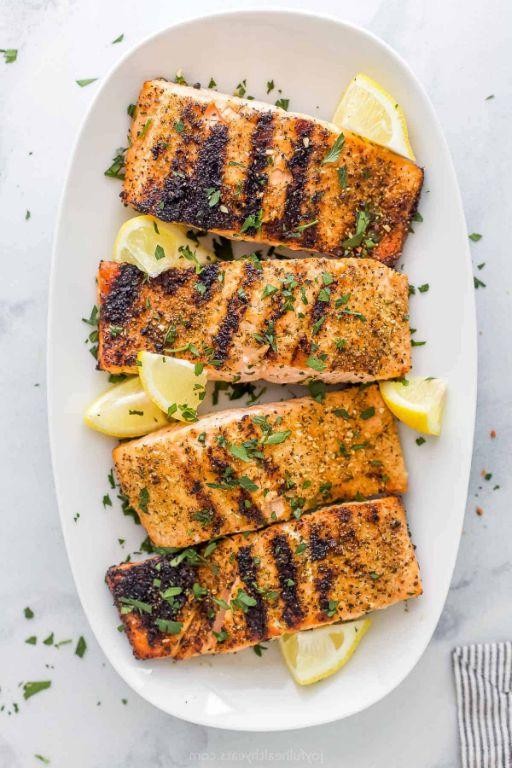
Heralding the arrival of spring with its vibrant flavors, this grilled lemon pepper salmon celebrates the delicate balance between citrus brightness and earthy spice. Perfectly charred edges give way to flaky, moist flesh that practically melts on the tongue, making it an ideal centerpiece for both casual weeknight dinners and elegant entertaining. The marriage of freshly cracked peppercorns and zesty lemon creates a symphony of flavors that dances across the palate.
4
servings15
minutes10
minutesIngredients
– 4 (6-ounce) skin-on wild-caught salmon fillets
– 3 tablespoons extra-virgin olive oil
– 2 tablespoons freshly squeezed lemon juice
– 1 tablespoon lemon zest, finely grated
– 2 teaspoons freshly cracked black peppercorns
– 1 teaspoon coarse sea salt
– 2 garlic cloves, minced
– 1 tablespoon unsalted butter, cold and cubed
– 2 lemon halves, for grilling
Instructions
1. Preheat a gas or charcoal grill to medium-high heat, achieving a consistent temperature of 400°F.
2. Pat the skin-on wild-caught salmon fillets completely dry using paper towels to ensure proper searing.
3. Whisk together the extra-virgin olive oil, freshly squeezed lemon juice, and minced garlic cloves in a small bowl until emulsified.
4. Brush the salmon fillets generously with the olive oil mixture, coating both the flesh and skin sides evenly.
5. Combine the freshly cracked black peppercorns, finely grated lemon zest, and coarse sea salt in a separate small bowl.
6. Press the pepper mixture firmly onto the salmon flesh side, creating an even crust that will adhere during cooking.
7. Place the salmon fillets skin-side down on the preheated grill grates, arranging them diagonally for optimal grill marks.
8. Grill undisturbed for 4-6 minutes until the skin releases easily and develops deep golden char marks.
9. Carefully flip the fillets using a fish spatula and cook flesh-side down for 2-3 minutes until the internal temperature reaches 125°F for medium-rare.
10. Add the cold, cubed unsalted butter to the grill grates beside the salmon during the final minute of cooking to create a basting sauce.
11. Place the lemon halves cut-side down on the grill and cook for 2-3 minutes until caramelized and lightly charred.
12. Remove the salmon from the grill and immediately baste with the melted butter using the grilled lemon halves.
13. Let the salmon rest for 3 minutes before serving to allow the juices to redistribute evenly throughout the flesh. Ultimately, the finished dish presents with a crisp, peppery crust that yields to remarkably tender, flaky flesh beneath. The caramelized lemon halves provide both visual appeal and an extra burst of citrus when squeezed over the salmon, while the butter basting creates a luxurious sheen that enhances every bite. Consider serving atop a bed of herbed farro or alongside roasted asparagus spears for a complete seasonal meal that showcases the salmon’s sophisticated flavor profile.
Lemon Chia Seed Pudding

Yielded from the simplest of ingredients, this lemon chia seed pudding transforms humble components into an ethereal dessert that balances bright citrus notes with delicate textural intrigue. Your morning routine or elegant dinner finale will be forever elevated by this effortless creation that belies its sophisticated flavor profile.
2
servings10
minutesIngredients
– ½ cup organic white chia seeds
– 2 cups cold whole milk
– ¼ cup freshly squeezed lemon juice
– 3 tablespoons raw wildflower honey
– 1 teaspoon pure vanilla extract
– ½ teaspoon finely grated lemon zest
– Pinch of Maldon sea salt
– Fresh mint sprigs for garnish
– Seasonal berries for serving
Instructions
1. Combine ½ cup organic white chia seeds and 2 cups cold whole milk in a glass mixing bowl, whisking vigorously for 30 seconds to prevent clumping. 2. Drizzle in ¼ cup freshly squeezed lemon juice while continuously whisking to incorporate smoothly. 3. Add 3 tablespoons raw wildflower honey, 1 teaspoon pure vanilla extract, and ½ teaspoon finely grated lemon zest, whisking until the honey completely dissolves. 4. Sprinkle a pinch of Maldon sea salt over the mixture and whisk for 15 seconds to distribute evenly. 5. Cover the bowl tightly with plastic wrap, ensuring it touches the pudding surface to prevent skin formation. 6. Refrigerate the mixture for exactly 8 hours or overnight until the pudding achieves a thick, spoonable consistency. 7. Divide the set pudding among four serving glasses using a rubber spatula to transfer every bit. 8. Garnish each portion with fresh mint sprigs and arrange seasonal berries artfully around the edges. Beyond its creamy texture, the pudding delivers a vibrant citrus melody that dances between the honey’s floral sweetness and the chia’s subtle crunch. Consider layering it with macerated stone fruits or serving alongside almond tuiles for contrasting crispness—each variation reveals new dimensions of this versatile dessert.
Lemon and Dill Potato Salad

Lemon and dill potato salad offers a refreshing departure from traditional mayonnaise-heavy versions, featuring bright citrus notes and herbaceous undertones that elevate this classic side dish to new heights of sophistication.
6
servings15
minutes22
minutesIngredients
- 2 pounds Yukon Gold potatoes, scrubbed
- 1/4 cup extra virgin olive oil
- 3 tablespoons freshly squeezed lemon juice
- 1 teaspoon Dijon mustard
- 1/2 cup finely chopped fresh dill
- 1/4 cup thinly sliced scallions
- 1/2 teaspoon sea salt
- 1/4 teaspoon freshly cracked black pepper
Instructions
- Place scrubbed Yukon Gold potatoes in a large stockpot and cover with cold water by 2 inches.
- Bring the water to a rolling boil over high heat, then reduce to a gentle simmer and cook for 18-22 minutes until potatoes are fork-tender but not falling apart.
- While potatoes cook, whisk together extra virgin olive oil, freshly squeezed lemon juice, and Dijon mustard in a small bowl until emulsified.
- Drain the cooked potatoes thoroughly and allow them to cool just until they can be handled safely.
- Cut the warm potatoes into 3/4-inch cubes, which helps them better absorb the dressing while maintaining structural integrity.
- Transfer the cubed potatoes to a large mixing bowl and gently fold in the emulsified dressing while potatoes are still warm.
- Add finely chopped fresh dill, thinly sliced scallions, sea salt, and freshly cracked black pepper to the dressed potatoes.
- Toss the mixture gently with a rubber spatula to evenly distribute all ingredients without crushing the potato pieces.
- Cover the bowl with plastic wrap and refrigerate for at least 1 hour to allow flavors to meld and develop complexity.
Refreshingly bright and herbaceous, this potato salad achieves perfect harmony between creamy potato interiors and the crisp, clean flavors of lemon and dill. The absence of mayonnaise allows the natural earthiness of Yukon Gold potatoes to shine through, while the acidic dressing penetrates deeply into the warm potatoes during tossing. Consider serving alongside grilled wild salmon or as part of an elegant picnic spread, where its vibrant colors and sophisticated flavor profile will undoubtedly impress.
Lemon Poppy Seed Muffins
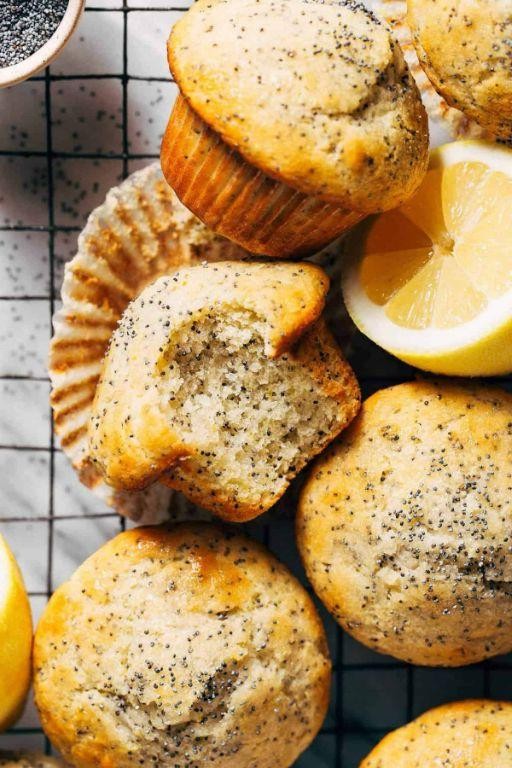
Yielded from the harmonious marriage of citrus and spice, these lemon poppy seed muffins embody spring’s awakening in pastry form. Their golden crowns, delicately crisp, give way to a tender crumb infused with the vibrant zest of sun-kissed lemons. Each bite releases the subtle nuttiness of poppy seeds, creating a symphony of textures and flavors that elevates the humble muffin to new heights.
12
muffins15
minutes22
minutesIngredients
- 2 cups all-purpose flour, sifted
- 1 tablespoon baking powder
- ½ teaspoon fine sea salt
- 1 cup granulated cane sugar
- 2 large pasture-raised eggs, lightly beaten
- 1 cup whole milk, at room temperature
- ½ cup European-style cultured butter, melted and cooled
- 2 tablespoons fresh lemon zest, finely grated
- ¼ cup fresh lemon juice, freshly squeezed
- 2 tablespoons poppy seeds
- 1 teaspoon pure vanilla extract
Instructions
- Preheat your oven to 375°F and position the rack in the center of the oven.
- Line a standard 12-cup muffin tin with parchment paper liners.
- Whisk together the sifted all-purpose flour, baking powder, and fine sea salt in a medium bowl.
- Combine the granulated cane sugar and lightly beaten pasture-raised eggs in a separate large mixing bowl.
- Whisk the mixture vigorously for exactly 2 minutes until pale and slightly thickened.
- Stream in the room temperature whole milk while continuously whisking.
- Add the cooled melted European-style cultured butter in a steady pour.
- Incorporate the freshly squeezed lemon juice and pure vanilla extract.
- Gently fold the dry ingredients into the wet mixture using a rubber spatula until just combined.
- Add the finely grated fresh lemon zest and poppy seeds, folding until evenly distributed.
- Divide the batter equally among the 12 prepared muffin cups, filling each three-quarters full.
- Bake for 18-22 minutes until the tops spring back when lightly pressed and a toothpick inserted comes out clean.
- Transfer the muffins to a wire cooling rack immediately after removal from the oven.
- Allow the muffins to cool completely before serving, approximately 30 minutes.
Soaring with citrus brightness, these muffins achieve perfect textural balance between their crisp exterior and cloud-like interior. Serve them warm with a dollop of lemon curd or alongside afternoon tea for an elegant treat that captures sunlight in every crumb.
Lemon Thyme Roasted Chicken
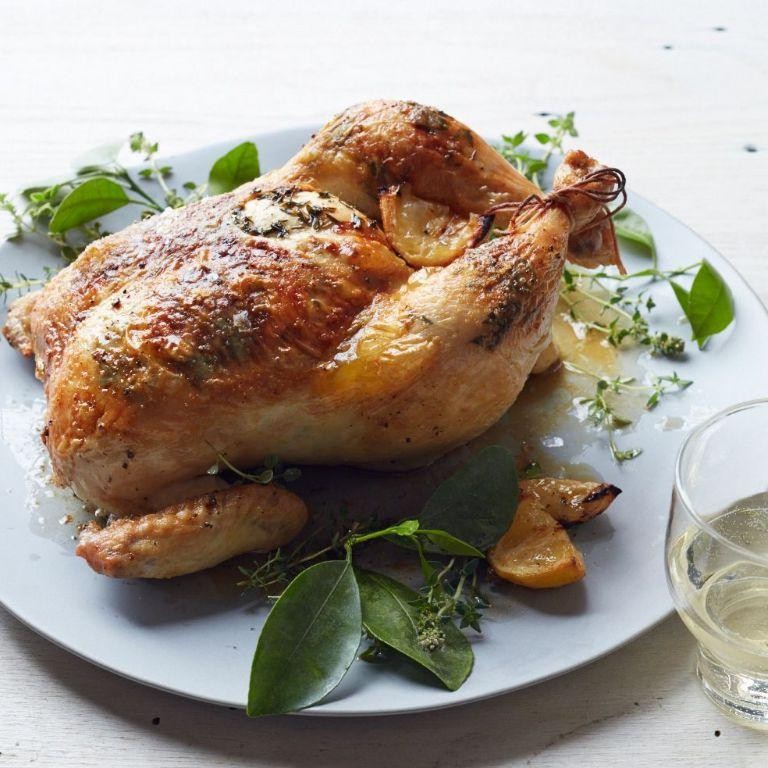
Nestled between the crisp autumn air and the warmth of home, this Lemon Thyme Roasted Chicken elevates simple ingredients into a masterpiece of comfort and elegance. The bright citrus notes dance harmoniously with earthy thyme, while golden skin gives way to impossibly juicy meat beneath. Each bite delivers the perfect balance of sophistication and soul-warming familiarity that transforms an ordinary evening into something extraordinary.
4
servings15
minutes90
minutesIngredients
- 1 whole pasture-raised chicken (4-5 pounds), patted dry
- 3 tablespoons clarified butter, melted
- 2 fresh lemons, one thinly sliced and one juiced
- 4 sprigs fresh thyme, plus 1 tablespoon leaves
- 3 cloves garlic, crushed
- 1 teaspoon fine sea salt
- ½ teaspoon freshly cracked black pepper
- 1 cup low-sodium chicken stock
Instructions
- Preheat your oven to 425°F and position a rack in the center.
- Season the chicken cavity generously with half the sea salt and black pepper.
- Stuff the cavity with lemon slices, thyme sprigs, and crushed garlic cloves.
- Truss the chicken legs with kitchen twine to ensure even cooking.
- Brush the entire surface with clarified butter, ensuring complete coverage.
- Rub the remaining salt, pepper, and thyme leaves over the skin.
- Place the chicken breast-side up in a heavy roasting pan.
- Roast for 15 minutes at 425°F to crisp the skin, then reduce heat to 375°F.
- Continue roasting for 60-75 minutes, basting every 20 minutes with pan juices.
- Check for doneness when the internal temperature reaches 165°F in the thickest part of the thigh and juices run clear.
- Transfer the chicken to a carving board and let rest for 15 minutes to redistribute juices.
- While resting, deglaze the pan with chicken stock and lemon juice, scraping up browned bits.
- Simmer the pan sauce for 5 minutes until slightly reduced and glossy.
- Carve the chicken and serve immediately with the warm pan sauce.
The skin emerges crackling-crisp, giving way to impossibly moist meat infused with herbal fragrance. Serve carved over creamy polenta or alongside roasted root vegetables, allowing the bright pan sauce to tie each element together in a symphony of textures and flavors that celebrates simplicity at its most refined.
Lemon Blueberry Scones

Gracefully bridging the gap between breakfast pastry and afternoon indulgence, these lemon blueberry scones offer a sublime balance of bright citrus and sweet berries. Each tender crumb carries the sophisticated essence of freshly grated lemon zest, while plump blueberries burst with seasonal flavor. This elegant treat elevates any morning ritual or elevates afternoon tea with its refined simplicity.
8
scones15
minutes22
minutesIngredients
– 2 cups all-purpose flour, sifted
– 1/3 cup granulated cane sugar
– 1 tablespoon baking powder
– 1/2 teaspoon fine sea salt
– 1/2 cup European-style unsalted butter, chilled and cubed
– 1/2 cup heavy cream, chilled
– 1 pasture-raised egg, lightly beaten
– 1 tablespoon freshly grated lemon zest
– 1 cup fresh blueberries
– 1 tablespoon turbinado sugar for finishing
Instructions
1. Preheat your oven to 400°F and line a baking sheet with parchment paper.
2. In a large mixing bowl, whisk together the sifted all-purpose flour, granulated cane sugar, baking powder, and fine sea salt until thoroughly combined.
3. Add the chilled, cubed European-style unsalted butter to the dry ingredients.
4. Using a pastry blender or your fingertips, work the butter into the flour mixture until it resembles coarse crumbs with some pea-sized butter pieces remaining—this technique ensures flaky layers.
5. Create a well in the center of the mixture and pour in the chilled heavy cream, lightly beaten pasture-raised egg, and freshly grated lemon zest.
6. Gently fold the wet ingredients into the dry mixture using a rubber spatula until just combined, being careful not to overmix.
7. Carefully fold in the fresh blueberries, distributing them evenly throughout the dough while minimizing berry breakage.
8. Turn the dough out onto a lightly floured surface and gently pat it into a 1-inch thick circle.
9. Using a sharp knife or bench scraper, cut the circle into 8 equal wedges.
10. Arrange the wedges on the prepared baking sheet, leaving 2 inches between each scone for proper air circulation.
11. Brush the tops of the scones lightly with additional heavy cream and sprinkle generously with turbinado sugar.
12. Bake for 18-22 minutes, or until the scones are golden brown on top and a toothpick inserted into the center comes out clean.
13. Transfer the baked scones to a wire rack and allow them to cool for 15 minutes before serving.
Subtly crisp exteriors give way to remarkably tender, buttery interiors where lemon zest perfumes each bite and blueberries offer sweet bursts of flavor. Serve these warm scones alongside clotted cream and lemon curd for an elevated afternoon experience, or enjoy them as they are with your morning coffee—their sophisticated simplicity makes them equally suited for casual breakfasts and elegant gatherings.
Honey Lemon Glazed Carrots
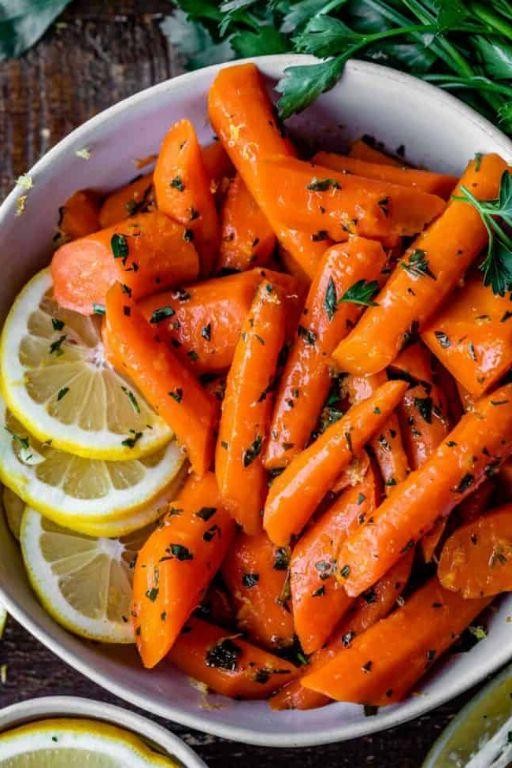
Kindly consider this elegant transformation of humble carrots into a sophisticated side dish, where caramelized edges meet a glossy, citrus-kissed glaze that elevates the vegetable to new heights of culinary refinement.
4
servings15
minutes30
minutesIngredients
- 1 pound heirloom carrots, peeled and cut into uniform 2-inch batons
- 2 tablespoons European-style unsalted butter
- 2 tablespoons raw wildflower honey
- 1 tablespoon freshly squeezed lemon juice
- 1 teaspoon finely grated lemon zest
- 1/4 teaspoon Maldon sea salt flakes
- 1/8 teaspoon freshly cracked Tellicherry black pepper
- 1 tablespoon chopped fresh Italian parsley
Instructions
- Preheat your oven to 425°F and position a rack in the center of the oven.
- Arrange the carrot batons in a single layer on a heavy-gauge rimmed baking sheet, ensuring they do not touch for optimal caramelization.
- Melt the European-style unsalted butter in a small saucepan over medium heat until just foaming, about 2 minutes.
- Drizzle the melted butter evenly over the carrots, using a pastry brush to coat each baton thoroughly for uniform cooking.
- Roast the carrots for 18-22 minutes, until they develop golden edges and can be pierced easily with a paring knife.
- Meanwhile, combine the raw wildflower honey, freshly squeezed lemon juice, and finely grated lemon zest in the same saucepan, whisking until emulsified.
- Heat the honey-lemon mixture over medium-low heat for 3-4 minutes until it thickens slightly and becomes aromatic.
- Remove the carrots from the oven and immediately pour the warm glaze over them, tossing gently to coat every surface.
- Return the glazed carrots to the oven and roast for an additional 4-6 minutes until the glaze becomes sticky and glossy.
- Transfer the finished carrots to a serving platter and season immediately with Maldon sea salt flakes and freshly cracked Tellicherry black pepper.
- Garnish with chopped fresh Italian parsley just before serving to maintain its vibrant color and fresh flavor.
These honey lemon glazed carrots achieve a perfect textural balance between tender interiors and caramelized exteriors, with the bright acidity of lemon cutting through the richness of the honey glaze. Their vibrant orange hue and glossy sheen make them particularly stunning when arranged alongside roasted poultry or as part of a holiday spread, where their sophisticated sweetness complements savory mains beautifully. The subtle floral notes from the wildflower honey create a nuanced complexity that distinguishes this preparation from ordinary glazed carrots.
Lemon Caper Sauce with Fish
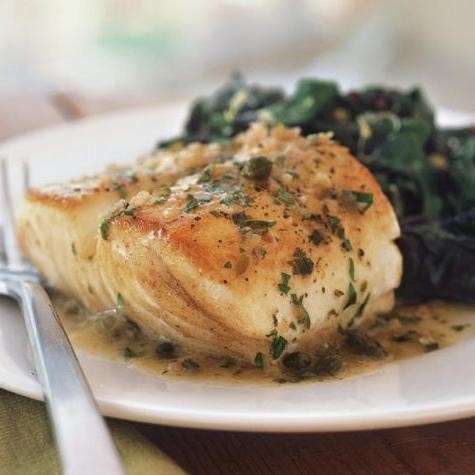
Wondrously bright and sophisticated, this lemon caper sauce transforms simple fish fillets into an elegant dinner centerpiece. The vibrant citrus notes dance beautifully with the briny capers, creating a sauce that feels both luxurious and refreshingly light. Perfect for weeknight dinners that deserve a touch of culinary magic, this dish comes together with restaurant-quality flair in under thirty minutes.
5
portions10
minutes15
minutesIngredients
- 4 (6-ounce) skinless white fish fillets (such as cod or halibut)
- 1/4 cup all-purpose flour
- 1 teaspoon kosher salt
- 1/2 teaspoon freshly ground black pepper
- 3 tablespoons clarified butter
- 2 garlic cloves, minced
- 1/2 cup dry white wine
- 1/4 cup freshly squeezed lemon juice
- 3 tablespoons brined capers, drained
- 2 tablespoons cold unsalted butter, cubed
- 2 tablespoons fresh Italian parsley, finely chopped
Instructions
- Pat the fish fillets completely dry with paper towels to ensure proper searing.
- Combine the flour, kosher salt, and black pepper in a shallow dish.
- Dredge each fish fillet lightly in the flour mixture, shaking off any excess.
- Heat clarified butter in a large skillet over medium-high heat until shimmering but not smoking.
- Place fish fillets in the hot skillet and cook for 3-4 minutes until golden brown crust forms.
- Carefully flip fillets using a thin spatula and cook for another 2-3 minutes until flesh flakes easily with a fork.
- Transfer cooked fish to a warm plate and tent loosely with foil to rest.
- Add minced garlic to the same skillet and sauté for 30 seconds until fragrant but not browned.
- Pour in dry white wine to deglaze the pan, scraping up all the browned bits from the bottom.
- Simmer the wine for 2 minutes until reduced by half, concentrating the flavors.
- Stir in freshly squeezed lemon juice and drained capers, heating through for 1 minute.
- Reduce heat to low and whisk in cold butter cubes one at a time until the sauce emulsifies and thickens slightly.
- Remove the skillet from heat and stir in finely chopped Italian parsley.
- Spoon the warm lemon caper sauce generously over the rested fish fillets.
Key to this dish’s elegance is the contrast between the delicate, flaky fish and the vibrant, buttery sauce that clings beautifully to each bite. The capers provide delightful bursts of briny complexity against the bright citrus notes, while the clarified butter ensures a clean, rich foundation without burning. Consider serving over creamy polenta or alongside roasted asparagus to create a complete meal that feels both sophisticated and comforting.
Lemon Cream Cheese Frosting
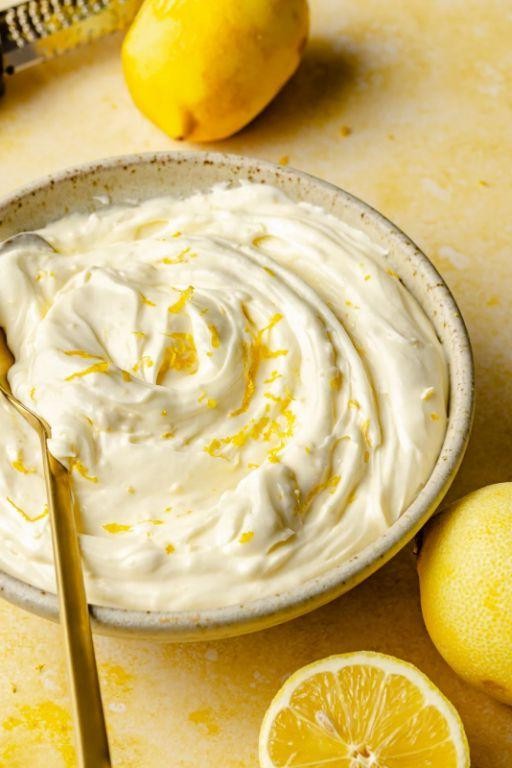
Radiantly balancing citrus brightness with creamy indulgence, this lemon cream cheese frosting transforms ordinary desserts into extraordinary creations. Its sophisticated flavor profile marries the vibrant acidity of fresh lemons with the luxurious richness of premium cream cheese, creating a versatile topping that elevates everything from classic carrot cake to delicate vanilla cupcakes. The result is a frosting that manages to be simultaneously refreshing and decadent, with a texture that spreads like velvet and holds its shape beautifully.
12
servings15
minutesIngredients
– 8 ounces full-fat cream cheese, at room temperature
– ½ cup unsalted European-style butter, softened
– 3 cups confectioners’ sugar, sifted
– 2 tablespoons fresh lemon juice, strained
– 1 tablespoon finely grated lemon zest
– ¼ teaspoon fine sea salt
Instructions
1. Place the room-temperature cream cheese and softened butter in the bowl of a stand mixer fitted with the paddle attachment.
2. Beat the cream cheese and butter on medium speed for exactly 3 minutes, until completely smooth and free of lumps.
3. Reduce the mixer speed to low and gradually add the sifted confectioners’ sugar in three additions, allowing each to incorporate fully before adding the next.
4. Scrape down the sides and bottom of the bowl with a flexible spatula to ensure even mixing.
5. Add the strained fresh lemon juice, finely grated lemon zest, and fine sea salt to the mixture.
6. Increase the mixer speed to medium-high and beat for exactly 2 minutes, until the frosting becomes light and fluffy.
7. Check the frosting’s consistency by lifting the paddle—it should form soft peaks that hold their shape.
8. Transfer the finished frosting to an airtight container if not using immediately.
Yieldingly smooth and luxuriously creamy, this frosting maintains perfect pipeability while delivering a sophisticated balance of tangy citrus and rich dairy notes. The fine sea salt enhances the lemon’s brightness without making the frosting taste salty, creating layers of flavor that develop beautifully when chilled. Consider using it to fill delicate macarons or as an elegant topping for lemon lavender scones for an unexpected twist on afternoon tea.
Lemon Herb Couscous
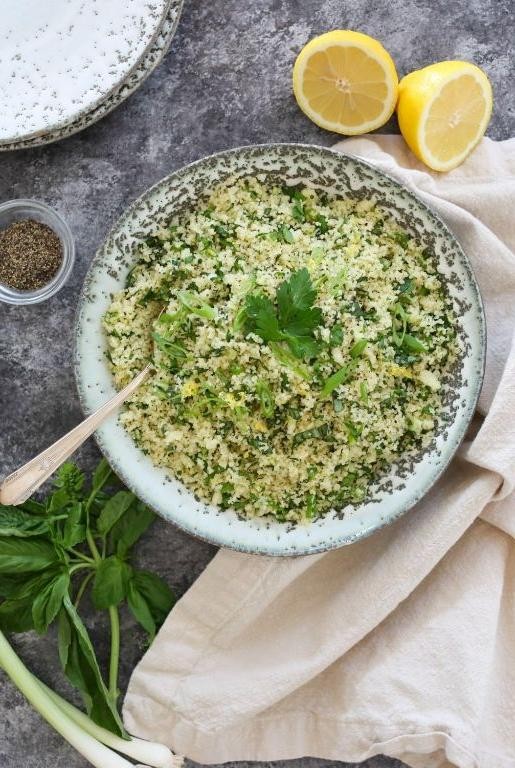
Kindling the senses with its vibrant Mediterranean essence, this lemon herb couscous transforms humble grains into an elegant canvas of bright citrus and aromatic freshness. Perfectly balanced between delicate texture and assertive flavor, it serves as both a sophisticated side dish and a stunning base for grilled proteins or roasted vegetables. Each forkful delivers a symphony of herbal notes punctuated by the clean acidity of freshly squeezed lemon juice.
5
servings15
minutes15
minutesIngredients
– 1 ½ cups Israeli pearl couscous
– 2 cups homemade vegetable stock, heated to boiling
– 3 tablespoons extra virgin olive oil, first cold press
– 2 medium organic lemons, freshly zested and juiced
– ¼ cup finely minced fresh flat-leaf parsley
– 2 tablespoons chopped fresh dill fronds
– 1 tablespoon fresh thyme leaves
– 1 small shallot, finely diced
– 1 garlic clove, microplaned
– ½ teaspoon Maldon sea salt flakes
– ¼ teaspoon freshly cracked black peppercorns
Instructions
1. Heat 1 tablespoon of extra virgin olive oil in a medium saucepan over medium heat until shimmering but not smoking.
2. Add the Israeli pearl couscous and toast for 3-4 minutes, stirring constantly with a wooden spoon until grains develop a light golden hue and release a nutty aroma.
3. Pour in the 2 cups of boiling homemade vegetable stock immediately, taking care as the mixture will steam vigorously.
4. Reduce heat to low, cover the saucepan tightly with a lid, and simmer for 8-10 minutes until the couscous has absorbed all liquid and appears tender yet al dente.
5. Transfer the cooked couscous to a wide ceramic bowl and spread it in a thin layer to cool slightly for 5 minutes, which prevents clumping and allows steam to escape evenly.
6. While the couscous cools, combine the remaining 2 tablespoons of extra virgin olive oil, freshly squeezed lemon juice, microplaned garlic, and finely diced shallot in a small glass bowl.
7. Whisk the dressing vigorously for 30 seconds until the mixture emulsifies and appears slightly thickened.
8. Drizzle the emulsified dressing over the warm couscous while using a fork to fluff and separate the grains, ensuring even distribution.
9. Fold in the freshly grated lemon zest, minced flat-leaf parsley, chopped dill fronds, and thyme leaves with gentle turning motions to preserve the herbs’ delicate structure.
10. Season with Maldon sea salt flakes and freshly cracked black peppercorns, then let the dish rest for 5 minutes to allow flavors to meld before serving.
Your finished couscous should showcase distinct, pearled grains that yield pleasantly to the tooth while the vibrant herb medley creates a confetti-like appearance throughout. The bright citrus notes cut through the richness of the olive oil beautifully, making this versatile dish equally suited for elegant dinner parties or casual al fresco dining when paired with grilled lamb chops or roasted cherry tomatoes.
Conclusion
More than just a flavor boost, these 24 lemon-inspired recipes bring fresh, vibrant energy to your kitchen. From zesty mains to bright desserts, there’s something here to delight every palate. We’d love to hear which recipes become your favorites—drop a comment below and share this roundup on Pinterest to spread the citrus love!



